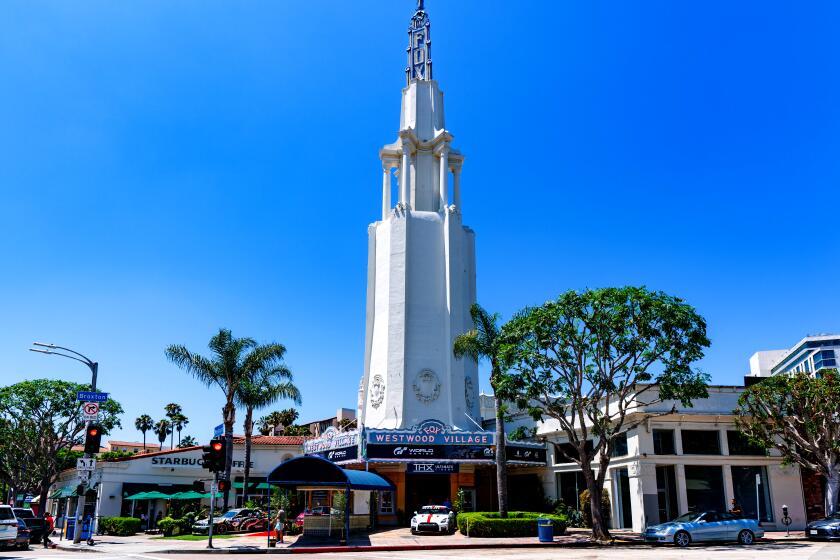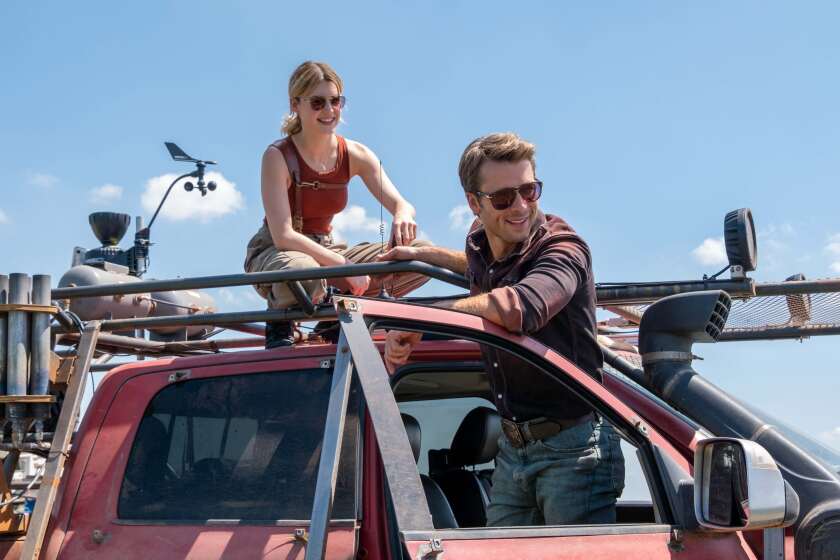MOVIES : The Glory That Was Hollywood : It cost $12 million to make ‘Spartacus’ in 1960. Today’s tag? Maybe $110 million. Thisweek the epic, restored and expanded, will open again.
The year was 1960 and Time magazine was among the many to publicly gulp at the cost of Stanley Kubrick’s gladiator epic, “Spartacus.” Its price tag of $12 million made it not only the most expensive movie ever made, the magazine noted, but equaled “the average annual revenue of the Roman Republic at the time of Spartacus.”
Well, coin has always been relative; ticket prices for Christians vs. lions games in the Colosseum presumably didn’t cost spectators an arm and a leg in those days, either. But when compared to the costs of making and marketing movies today--just 31 years after “Spartacus” opened at New York City’s De Mille Theater--it was an epic bargain.
Consider the figures: Shot over a 167-day period, using 100 major sets, a cast and crew of more than 10,000, 5,000 costumes, 7 tons of armor and 27 tons of rented museum statuary, and featuring such then-illustrious stars as Kirk Douglas, Laurence Olivier and Tony Curtis.
Just imagine what it would cost to make now, when . . .
* A “little” picture like “Home Alone” costs $18 million.
* The average major studio movie costs about $25 million, according to the Motion Picture Assn. of America.
* An epic gangster film like “The Godfather Part III” costs about $60 million, and a special-effects orgy like “Total Recall” runs a tab of maybe $80 million.
* The cost of restoring the version of “Spartacus” that will be reissued in U.S. theaters Friday totaled about one tenth of the film’s original production budget.
* And the cost of marketing any major studio movie put into national release--good or bad, extravagant or cheesy--can run as much as “Spartacus’ ” $12 million total.
Stanley Kubrick, producer Douglas, Universal Pictures and their financial backers got a pretty good deal, even if the movie barely earned back its money at the time. It has become a classic of the era of the wide-screen epic, of that frantic historical moment when the studios attempted to counter-program TV with 70-millimeter period spectacles.
Imagine some of those scenes in “Spartacus”--the vast gladiator school where Spartacus (Douglas) fought for his freedom, built from scratch from 2,000-year-old designs, or the climactic battle between the armies of Spartacus and Rome’s Crassus (Olivier), filmed on the Spanish plains near Madrid with 8,500 extras forming the massive Roman Legion--and try to imagine re-creating all of that today.
“You couldn’t do it again. Not the way they did it then,” said C. O. (Doc) Erickson, a veteran production executive who surveyed the original “Spartacus” budget. Should anyone try, he said, they would have to go “someplace in Eastern Europe” to keep costs down. And, he added, they’d have to use extensive matte work, rather than building elaborate sets.
Erickson, who has worked on epics such as “Fall of the Roman Empire” and “Cleopatra,” and even the second unit of “Spartacus,” estimated that if someone were intent on remaking “Spartacus,” consistent with the cast assembled and look achieved in the original, and if they were lucky enough to get it done with no major production setbacks, the cost would run at least $110 million. It would cost the distributor no less than $20 million to market it, say other industry sources, and if it were to succeed at the box office--as it would need to in order to become profitable--the costs of marketing and advertising could reach $50 million.
So far, nobody is suggesting a ‘90s version of “Spartacus” with, say, an $8-million man like Mel Gibson or Tom Cruise in the lead toga, so epics fans will have to settle for the restored version of the original. But thanks to the more liberal attitudes of today, “Spartacus” has been expanded to include some scenes considered too violent or too raw by 1960’s industry censors. Among the restored footage is the legendary lost moment when Olivier’s general makes a homosexual advance toward his bathing slave, Antoninus (Curtis).
Despite the trims made for its 1960 release, many critics of the day were concerned with the film’s graphic content--”gore unlimited,” as the Los Angeles Mirror’s Dick Williams put it. In his review for Daily Variety, Tom Pryor wrote: “Realism has its place, but there may well be a limit to the shock audiences can be expected to take in Technicolor and on the magnified 70-mm film.”
Even with the homosexual pass and other moments of violence reinstated in the new three-hour and seven-minute version, “Spartacus” only rang up a PG-13 on the modern censors’ alarm system.
The idea for the film’s restoration came about after the American Cinematheque asked Universal Pictures for a print of the film for its recent salute to Kirk Douglas. “The print didn’t exist anymore; it had been butchered, and it had faded,” said James C. Katz, the producer of the restoration, which was done by Robert A. Harris, who restored “Lawrence of Arabia” two years earlier. Katz and Harris had worked together earlier on the restoration of Abel Gance’s silent epic, “Napoleon.”
Also involved in the project was “Spartacus” film editor Robert Lawrence, whose other credits include “El Cid,” “A Place in the Sun” and “Giant.”
And, by long-distance phone and fax from London, Kubrick participated in the restoration, even providing detailed instructions for handling the Olivier-Curtis scene. (Anthony Hopkins dubbed the voice-over for the late Olivier.)
Universal, which financed the restoration, is teaming up with American Film Institute for three premieres, with proceeds targeted for the AFI Preservation Fund ’91 and the Film Foundation. The Los Angeles premiere will be held Thursday at the Directors Guild of America Theater. The 70-mm “Spartacus” will open in Los Angeles, New York, Washington and Toronto on Friday. On May 3, it will begin a wider release in another 31 cities in the United States and Canada. And, depending on how well it plays, it will have a wider release later across the country. But, as one of the film’s publicists acknowledged, the real future of the restored “Spartacus” is in the coming special edition letter-boxed (banded top and bottom to provide the full wide-screen image) videotapes and laser discs.
Harris hopes that the film’s release will whet audience appetites for more big-format pictures. “If we were to bring back big screens and do pictures that are special on the big screen, people would flock to them,” he says. “Though the film industry has wonderful hits occasionally, you might as well watch 90% of the movies that are out there on video.”
The real-life Spartacus was born in Thrace in northeastern Greece. He was captured as a youth and brought to Rome where he was sold as a slave. It was at the gladiator training compound at Capua, 130 miles south of Rome, where he led a revolt of 78 slaves. In the ensuing two years, Spartacus and his army of freed slaves numbered about 90,000.
In a decisive battle in 71 BC, Spartacus and his men were defeated by the Roman army of Marcus Licinius Crassus; Spartacus was killed and 6,000 of his men were crucified along the Appian Way, from Capua to Rome.
Subject of writings by ancient authors, including Plutarch and Livy, Spartacus has come to symbolize man’s quest for freedom. In the ‘50s, Spartacus was the subject of several popular books, including a novel by Howard Fast that sold more than 3 million copies (in 45 languages). Producer Edward Lewis purchased the Fast book, which he then took to Kirk Douglas, who had begun executive-producing movies as well as starring in them. Another Spartacus novel had been purchased for Yul Brynner at United Artists, but that project fell apart when Olivier and Charles Laughton signed on for the cast of Douglas’ film.
Along with breaking budgetary rules, “Spartacus” helped to break the Hollywood blacklist. Dalton Trumbo, who had been blacklisted by the House Un-American Activities Committee in 1950, wrote the screenplay under the pseudonym “Sam Jackson.” At Douglas’ order, Trumbo received screenwriting credit in his own name. There was minimal fallout.
But it was just the beginning of the film’s controversial journey.
Filming had barely gotten under way on location in Southern California when original director Anthony Mann ran into creative differences with the producers and quit. Douglas replaced him with the 31-year-old Kubrick, for whom he had worked in the brilliant but poorly attended anti-war film “Paths of Glory.” German actress Sabina Bethmann, who had been cast in the female lead of the slave Varinia, was also replaced shortly after production began by the established Jean Simmons.
Most of “Spartacus” was shot in California--at Universal Studios and at locations in Death Valley, San Fernando Valley and along the coast, where the Pacific Ocean doubled for the Tyrrhenian Sea to the west of Rome. The film also marked the first time that permission was granted to shoot scenes at San Simeon’s Hearst Castle, which provided the exterior view of Crassus’ lavish Roman villa.
At Universal, historic sets from other movies were given a Roman make-over. A setting for “The Phantom of the Opera” became the villa for the Roman senator played by Charles Laughton. A battlefield that had seen action in 1930’s “All Quiet on the Western Front” gave way to warring Romans and slaves.
There was warring on the set, too, duly noted in the trade papers and local newspaper columns. Kubrick didn’t have the image or the control he would later have, and was apparently getting more directorial help than he wanted from the British superstars Olivier, Laughton and Peter Ustinov. Olivier and Ustinov had been particularly irksome, insisting on having outdoor settings duplicated on sound stages because, as Kubrick explained to one interviewer, they felt their “powers were just drifting off into space when they were working out of doors.”
Then, as now, journalists were interested in costs and producer Edward Lewis made headlines by acknowledging “Spartacus” would have to earn an astronomical $22 million at the box office to recoup its expenses. Then, as now, the jaw-dropping figures were released more as marketing hype than fiscal honesty; Lewis managed to lump “Spartacus” in with such celebrated predecessors as “Gone With the Wind,” “The Robe” and “The Ten Commandments” in saying “films that cost the most have the best chance of making the most.”
When it was released, some critics were ready to welcome “Spartacus” into the pantheon of period classics. “A new kind of Hollywood movie,” said Time magazine, “a superspectacle with spiritual vitality and moral force.” Writing in the New York Post, Archer Winsten deemed it a better movie than “Ben-Hur,” at least “in wit, characterizations and romance.” Daily Variety said it was “a whale of a motion picture” with “sheer pictorial poetry that is sweeping and savage, intimate and lusty, tender and bittersweet.”
Other critics were less enthusiastic, and the New York Times’ influential Bosley Crowther dismissed it almost out of hand, saying it was “pitched to the level of a lusty schoolboy’s taste.” Newsweek called it a “ragged toga saga.”
“Spartacus” ultimately made back its money, which must have been reassuring for the backers of the then-shooting “Cleopatra.” (The reassurance was momentary; “Cleopatra’s” budget quadrupled that of “Spartacus” and nearly destroyed 20th Century Fox.) And there were four Oscars, including ones for Ustinov as best supporting actor and Alex North for original music score. But in the war for the best-picture Oscar, “Spartacus” failed to even win a nomination. “The Apartment” won the year’s top honor over “The Alamo,” “Elmer Gantry,” “Sons and Lovers” and “The Sundowners.”
Today, “Spartacus” has come to be known as that rarest of epics--with its highly personal story about a man’s quest for freedom set against a sweeping backdrop. “It’s a picture for all people, not just an empty spectacle,” says Robert Lawrence. Robert Harris calls it “a literate and big, brawling Western that happens to take place in Rome.”
As Kubrick once explained: “We tried to do ‘Spartacus’ as if we were filming a ‘Marty’ . . . I tried to forget that this film was costing millions and that we had all the extras we wanted, and just thought in terms of what each scene was about and how the characters would honestly behave.”
More to Read
Only good movies
Get the Indie Focus newsletter, Mark Olsen's weekly guide to the world of cinema.
You may occasionally receive promotional content from the Los Angeles Times.






